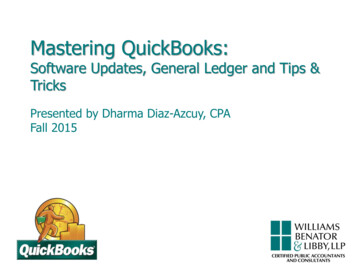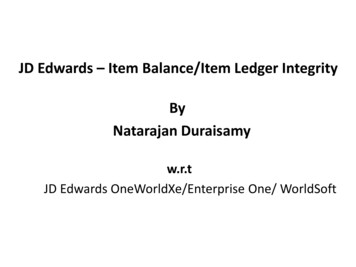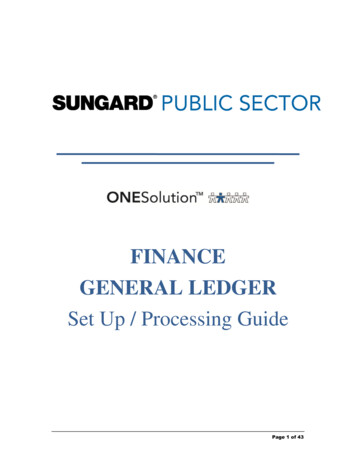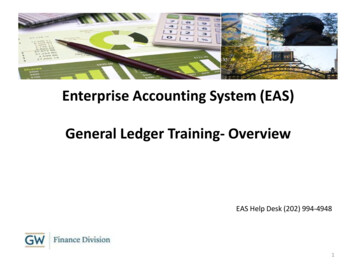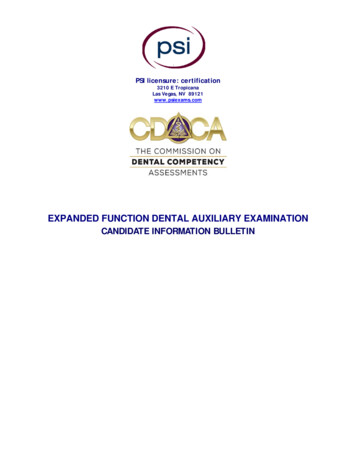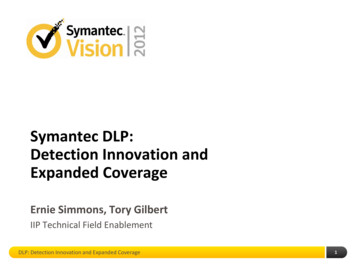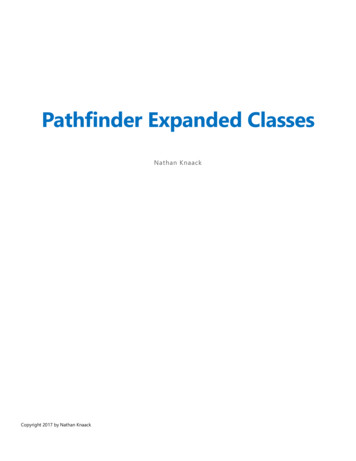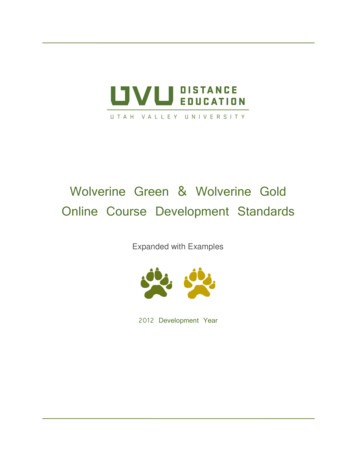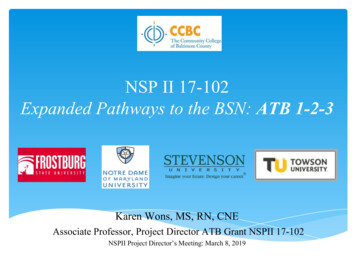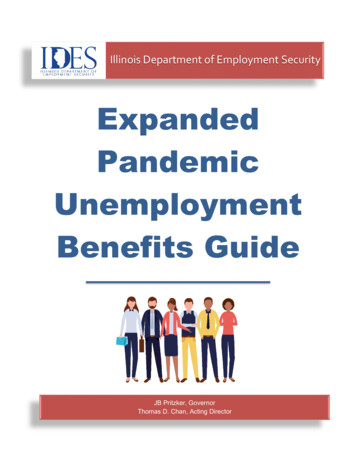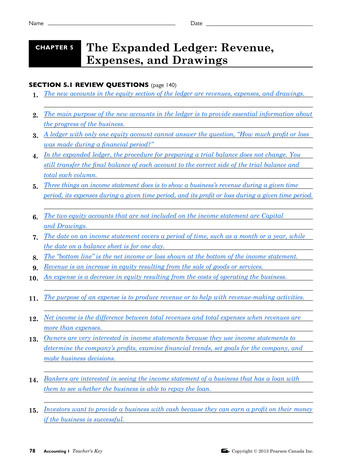
Transcription
NameDateCHAPTER 5The Expanded Ledger: Revenue,Expenses, and DrawingsSECTION 5.1 REVIEW QUESTIONS (page 140)1. The new accounts in the equity section of the ledger are revenues, expenses, and drawings.2. The main purpose of the new accounts in the ledger is to provide essential information aboutthe progress of the business.3. A ledger with only one equity account cannot answer the question, “How much profit or losswas made during a financial period?”4. In the expanded ledger, the procedure for preparing a trial balance does not change. Youstill transfer the final balance of each account to the correct side of the trial balance andtotal each column.5. Three things an income statement does is to show a business’s revenue during a given timeperiod, its expenses during a given time period, and its profit or loss during a given time period.6. The two equity accounts that are not included on the income statement are Capitaland Drawings.7. The date on an income statement covers a period of time, such as a month or a year, whilethe date on a balance sheet is for one day.8. The “bottom line” is the net income or loss shown at the bottom of the income statement.9. Revenue is an increase in equity resulting from the sale of goods or services.10. An expense is a decrease in equity resulting from the costs of operating the business.11. The purpose of an expense is to produce revenue or to help with revenue-making activities.12. Net income is the difference between total revenues and total expenses when revenues aremore than expenses.13. Owners are very interested in income statements because they use income statements todetermine the company’s profits, examine financial trends, set goals for the company, andmake business decisions.14. Bankers are interested in seeing the income statement of a business that has a loan withthem to see whether the business is able to repay the loan.15. Investors want to provide a business with cash because they can earn a profit on their moneyif the business is successful.78Accounting 1 Teacher’s KeyCopyright 2013 Pearson Canada Inc.
NameDateSECTION 5.1 REVIEW QUESTIONS (continued)16. A business must provide an income statement to the government as part of their annualincome tax return, which helps the government calculate the amount of income tax thebusiness owes.17. Drawings are not included on the income statement because they are not always directlyrelated to earning revenue or to supporting revenue-making activities.18. A chart of accounts is a list of the ledger accounts and their account numbers in ledger order.19. This text uses a three-digit account numbering system. Assets are numbered in the 100s.Liabilities are numbered in the 200s. Capital and Drawings are numbered in the 300s.Revenues are numbered in the 400s. Expenses are numbered in the 500s.20. An asset account normally has a debit balance. A liability account normally has a creditbalance. A Revenue account normally has a credit balance. An Expense account normallyhas a debit balance. The Drawings account normally has a debit balance. The Capitalaccount normally has a credit balance.21. The Capital account will normally contain the beginning equity figure and new investmentsfrom the owner.SECTION 5.1 EXERCISES (page 141)Exercise 1, p. 141A. The heading should use Mayfare Plumbing instead of the owner’s name. Mayfare Plumbing should be the first line in the heading. Income Statement should be the second line of the heading. The third line of the heading should have Year Ended before the date, since it covers aperiod of time not a single date. The Capital account should not be listed on the income statement. There is only one revenue account, so the revenue total should be listed in the rightcolumn on the same line as Sales and Service. Add a blank line between Total Revenue and Operating Expense The Drawings account should not be included on the income statement. Gas and Oil should be written as Gas and Oil Expense. Utilities should be written as Utilities Expense. Total expenses should be 32 519.62. Net income should be 74 896.38. Change Net Profit to Net Income.Copyright 2013 Pearson Canada Inc.Chapter 5 The Expanded Ledger: Revenue, Expense, and Drawings79
NameDateSECTION 5.1 EXERCISES (continued)Exercise 1, p. 141 (continued)MAYFARE PLUMBINGB.INCOME STATEMENTYEAR ENDED DECEMBER 31, 20–Revenue 107 4 1 6Sales and Service–Operating Expenses 1 1 5 0 50Advertising ExpenseBank Charges1 7 5 0–Car Expense4 2 9 6–Gas and Oil4 9 3 5–15 9 0 6–Miscellaneous Expense2 5 7–Telephone Expense2 5 0–Materials Used3 9 7 5 12Utilities32 5 1 9 62Total Expenses 74 8 9 6 38Net IncomeExercise 2, p. 141Express Air Service Chart of AccountsAssetsBankNo.105EquityKarenKoy, CapitalNo.305AccountsReceivable110KarenKoy, lesAdvertisingExpenseBankCharges Expense505Airplanes135140515BuildingRepairs able210WagesExpense55080Accounting 1 Teacher’s Key410510520530Copyright 2013 Pearson Canada Inc.
NameDateSECTION 5.1 EXERCISES (continued)Exercise 3, p. 142EMILY STOKALUKA.TRIAL BALANCEMARCH 31, 20–ACCOUNTSDEBITCREDIT10 1 0 0–8 3 0 0–9 5 0–Land235 0 0 0–Building210 0 0 0–Equipment22 0 0 0–Automobiles24 0 0 0–BankAccounts ReceivableSupplies2 8 0 0–10 0 0 0–Mortgage Payable175 0 0 0–E. Stokaluk, Capital252 0 8 8–132 5 0 0–1 0 0 0–573 3 8 8–Accounts PayableBank LoanE. Stokaluk, Drawings15 0 0 0–Fees EarnedInterest Earned1 2 0 0–Bank Charges Expense3 5 0–Building Maintenance Expense4 2 0–Gas and Oil Expense1 8 0 0–Utilities Expense1 6 4 0–Miscellaneous Expense1 2 8–Car Repair Expense8 5 0–41 6 5 0–573 3 8 8–Advertising ExpenseWages ExpenseCopyright 2013 Pearson Canada Inc.Chapter 5 The Expanded Ledger: Revenue, Expense, and Drawings81
NameDateSECTION 5.1 EXERCISES (continued)Exercise 3, p. 142 (continued)B.E. Stokaluk Chart of AccountsAssetsBankAccounts .Stokaluk, singExpenseBankCharges Expense515BuildingMaintenance ExpenseGasand Oil penseMiscellaneousExpense525BankLoanMortgage Payable210CarRepair ExpenseWagesExpense535215310410510520530540EMILY STOKALUKC.INCOME STATEMENTMONTH ENDED MARCH 31, 20–RevenueFees EarnedInterest Earned 132 5 0 0–1 0 0 0–Total Revenue 133 5 0 0–48 0 3 8– 85 4 6 2–Expenses 1 2 0 0–Bank Charges Expense3 5 0–Building Maintenance Expense4 2 0–Gas and Oil Expense1 8 0 0–Utilities Expense1 6 4 0–Miscellaneous Expense1 2 8–Car Repair Expense8 5 0–41 6 5 0–Advertising ExpenseWages ExpenseTotal ExpensesNet Income82Accounting 1 Teacher’s KeyCopyright 2013 Pearson Canada Inc.
NameDateSECTION 5.1 EXERCISES (continued)Exercise 4, p. 142A., B.ASSETSBank1 300.20 Jul. 31 balanceTools and Equipment5 156.40 Jul. 31 balanceTruck6 100.00 Jul. 31 balanceLIABILITIESA/P—Kitzul Tools1 600.00Jul. 31 balanceEQUITYS. O’Neill, Capital9 455.60S. O’Neill, Drawings82 25013Renovation Revenue8 000 22 2508 00064 5005 0001121 000Gasoline Expense4 109.555110.719108.9910112.66Repairs Expense3 312.09Supplies Expense1 11 245441.91712Wages Expense1 5001 5003 000Copyright 2013 Pearson Canada Inc.Chapter 5 The Expanded Ledger: Revenue, Expense, and Drawings83
NameDateSECTION 5.1 EXERCISES (continued)Exercise 4, p. 142 (continued)MEADOWLARK MAKEOVERSC.TRIAL BALANCEJULY 31, 20–ACCOUNTSDEBITCREDITBank1 3 0 0 20Tools and Equipment5 1 5 6 40Truck6 1 0 0–A/P—Kitzul Tools1 6 0 0S. O’Neill, Capital9 4 5 5 604 5 0 0S. O’Neill, Drawings–21 0 0 0Renovation RevenueGasoline Expense4 4 1 91Repairs Expense3 1 2 09Supplies ExpenseWages Expense–11 2 4 5–3 0 0 0–32 0 5 5 60–32 0 5 5 60MEADOWLARK MAKEOVERSD.INCOME STATEMENTMONTH ENDED JULY 31, 20–RevenueRenovation Revenue 21 0 0 0–14 9 9 9– 6 0 0 1–Operating ExpensesGasoline ExpenseRepairs ExpenseSupplies ExpenseWages ExpenseTotal ExpensesNet Income 1 4 4 1 913 1 2 0911 2 4 5–3 0 0 0–E. Sean should be encouraged by the income statement for July. It shows a net income of 6001. That is 28.6% of revenue (6001 21 000). With this healthy profit, Sean was able towithdraw 4500 for personal living expenses (drawings), leaving 1501 of assets left over tohelp grow the business.84Accounting 1 Teacher’s KeyCopyright 2013 Pearson Canada Inc.
NameDateSECTION 5.2 REVIEW QUESTIONS (page 149)1. From their normal account balances, two conclusions you can make about equity transactionsare that revenues are normally credited and expenses and drawings are normally debited.2. You can be reasonably certain that revenue accounts will have a credit balance at the end ofthe year because debits to a revenue account are rare. Once a sale amount is recorded in theaccount, it usually remains there until year-end.3. You might want to debit a revenue account when recording a sales return.4. The revenue recognition principle requires a transaction to be recorded in the accounts ofa business at the time the transaction is completed.5. Before sending an invoice to a customer, the seller must fulfill its obligations to provide thepromised goods or services.6. The IFRS allow a seller to record a sale without having delivered the goods so long as it isprobable that delivery will be made; the item is on hand, identified, and ready for delivery;the buyer is aware of delayed delivery; and the usual payment terms apply.7. When purchasing advertising on credit, equity decreases from the debit to the AdvertisingExpense account even though no assets have left the business. This is due to the creditorhaving an increased claim on the business’s assets. The owner’s claim on those assets hasless priority than the creditors’, so the owner’s claim must decrease.8. Fiscal period is the period of time over which earnings are measured.9. The student’s statement is accurate in the sense that expenses are expired costs—they haveno future value or role. They have “given up their lives.” Additionally, the mission of theseexpired costs was to produce revenue or support revenue-making activities. When they aresubtracted from, or matched against, the revenues they produced or supported, net incomeor loss is revealed.SECTION 5.2 EXERCISES (page 150)Exercise 1, p. 150ASSETS1.SuppliesDrCr400 Cr400BankCrCopyright 2013 Pearson Canada Inc. EQUITYBankDr2.DrLIABILITIESDrCr1 000DrCrDrCrBank LoanDrCr1 000DrCrChapter 5 The Expanded Ledger: Revenue, Expense, and Drawings85
NameDateSECTION 5.2 EXERCISES (continued)Exercise 1, p. 150 (continued)ASSETSBank3.DrCr800 A/R––J. CheungDrCr800LIABILITIESDrDrCrDrCrDrDrCrFees EarnedDrCr9009005.A/R––B. HullDrCrDrCrDrEQUITYCrBank4. CrFees EarnedDrCr1 5001 00Truck9.DrCr600DrCrDrCrDrCrM. 0A/P––Advance NewsDrCr2 00086Cr20 00010.DrWages ExpenseDrCrBank20 000DrM. Hartman,DrawingsDrCr750Bank8.Utilities ExpenseDrCr125Bank7.DrCrAccounting 1 Teacher’s KeyAdvertisingExpenseDrCr2 000Copyright 2013 Pearson Canada Inc.
NameDateSECTION 5.2 EXERCISES (continued)Exercise 2, p. 1501.DebitsCreditsChemical SuppliesDrCrA/P—Pesticide ProductsDrCr125125Equipment2.DrCrA/P—Pro HardwareDrCr1503.150Wages ExpenseDrCrBankDrCr100100Bank4.DrCrLandscaping RevenueDrCr505.50A/R—G. YungDrCrLandscaping RevenueDrCr1006.100Advertising ExpenseDrCrA/P—Banner NewsDrCr507.50E. Inahaba, DrawingsDrCrBankDrCr1758.175Interest ExpenseDrCr909.Copyright 2013 Pearson Canada Inc.Cr90E. Inahaba, DrawingsDrCr100BankDrLandscaping RevenueDrCr100Chapter 5 The Expanded Ledger: Revenue, Expense, and Drawings87
NameDateSECTION 5.2 EXERCISES (continued)Exercise 3, p. 151A., B.ASSETSBankA/R––S. McNeil16 000 1 500234 000160651 200 1 80081 400911 20072 500Supplies48004 8606 340LIABILITIESBank Loan6 000A/P––Northern Utilities4001A/P––Percy’sOffice Outfitters800104EQUITYA. Dodds, Capital4 0003A. Dodds, Drawings9Fees Earned1 4001 20052 50073 700Rent Expense21 500Telephone Expense6160Utilities Expense10400Wages Expense8881 800Accounting 1 Teacher’s KeyCopyright 2013 Pearson Canada Inc.
NameDateSECTION 5.2 EXERCISES (continued)Exercise 3, p. 151 (continued)SPALDING CONSULTANTSC.TRIAL BALANCENOVEMBER 30, 20–ACCOUNTSDEBITBank6 3 4 0 –A/R—Sarah McNeil2 5 0 0 –CREDIT8 0 0 –Supplies6 0 0 0 –Bank LoanA/P—Percy’s Office Outfitters8 0 0 –A/P—Northern Utilities4 0 0 –4 0 0 0 –A. Dodds, Capital1 4 0 0 –A. Dodds, Drawings3 7 0 0 –Fees Earned1 5 0 0 –Rent ExpenseTelephone Expense1 6 0 –Utilities Expense4 0 0 –1 8 0 0 –Wages Expense14 9 0 0 –14 9 0 0 –Exercise 4, p. 152A. The Bank account normally has adebitbalance.B. A revenue account normally has acreditbalance.debitC. An expense account normally has aD. Paying a creditor involves aE. The Drawings account receives amoney for personal use.debitbalance.entry to the creditor’s account.debitentry when the owner withdrawsF. A lawyer gives a cash refund to a customer. The Bank account will receivecreditdebitentry and the Revenue account will receive aaentry.debitG. Supplies are bought on credit. The Supplies account will receive acreditentry.entry and the supplier’s account payable will receive acreditentries.H. The Drawings account will not normally receiveI. An increase in equity can be thought of as acreditJ. Net income can be thought of as aK. Net loss can be thought of as adebitcreditto the Capital account.to the Capital account.to the Capital account.L. The owner takes a computer from the business for his personal (permanent) use.debitentry.The Drawings account will receive aCopyright 2013 Pearson Canada Inc.Chapter 5 The Expanded Ledger: Revenue, Expense, and Drawings89
NameDateSECTION 5.2 EXERCISES (continued)Exercise 5, p. UITYExpenseDrawingsIncreaseDec
Name Date SECTION 5.2 REVIEW QUESTIONS (page 149) 1. 2. 3. 4. 5. 6. 7. 8. 9. SECTION 5.2 EXERCISES (page 150) Exercise 1, p. 150 ASSETS LIABILITIES EQUITY 1 .
